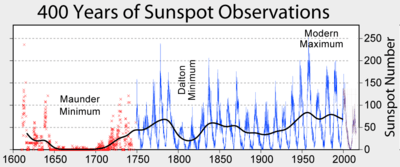Dalton Minimum
The Dalton Minimum was a period of low sunspot count, representing low solar activity, named after the English meteorologist John Dalton, lasting from about 1790 to 1830[1] or 1796 to 1820,[2] corresponding to the period solar cycle 4 to solar cycle 7.

Temperature
Like the Maunder Minimum and Spörer Minimum, the Dalton Minimum coincided with a period of lower-than-average global temperatures. During that period, there was a variation of temperature of about 1 °C in Germany.[3]
The cause of the lower-than-average temperatures and their possible relation to the low sunspot count are not well understood. Recent papers have suggested that a rise in volcanism was largely responsible for the cooling trend.[4]
While the Year Without a Summer, in 1816, occurred during the Dalton Minimum, the prime reason for that year's cool temperatures was the highly explosive 1815 eruption of Mount Tambora in Indonesia, which was one of the two largest eruptions in the past 2000 years. One must also consider that the rise in volcanism may have been triggered by lower levels of solar output as there is a weak but statistically significant link between decreased solar output and an increase in volcanism.[5]
See also
Notes
- Komitov and Kaftan 2004
- Archibald, p. 32
- File:Temperaturreihe Deutschland.png, red line, 1795 to 1815
- Wagner and Zorita, as well as Wilson.
- https://pubs.giss.nasa.gov/abs/st07500u.html
References
- Komitov, Boris and Vladimir Kaftan (2004) "The Sunspot Activity in the Last Two Millenia on the Basis of Indirect and Instrumental Indexes: Time Series Models and Their Extrapolations for the 21st Century", in Proceedings of the International Astronomical Union, 2004, pp. 113–114.
- Wagner, Sebastian and Eduardo Zorita (2005) "The influence of volcanic, solar and CO2 forcing on the temperatures in the Dalton Minimum (1790–1830): a model study", Climate Dynamics v. 25, pp. 205–218, doi 10.1007/s00382-005-0029-0.
- Wilson, Robert M. (nd) "Volcanism, Cold Temperature, and Paucity of Sunspot Observing Days (1818–1858): A Connection?", The Smithsonian/NASA Astrophysics Data System, accessed February 2009.